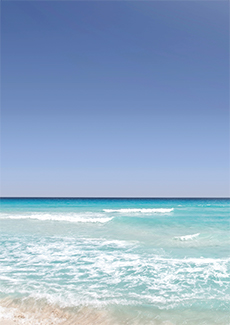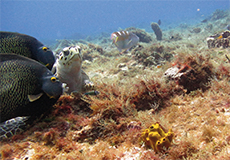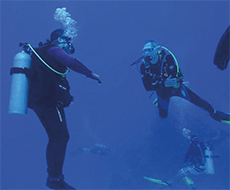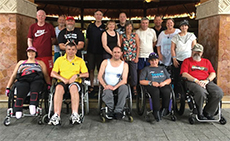




| Home | Features | Club Nights | Underwater Pics | Feedback | Non-Celebrity Diver | Events | 8 August 2025 |
| Blog | Archive | Medical FAQs | Competitions | Travel Offers | The Crew | Contact Us | MDC | LDC |

|

|
 
 |
    ISSUE 24 ARCHIVE - SCUBA TRUST HEAD TO COZUMELHoward SobeyIt was a just like any other morning. Not too hot, not too cold, not sunny, nor raining. Who would have guessed that this non-descript morning would see the coming together of the most motley, cut throat, villainous group in all Christendom. I refer of course to the purple shirted Scuba Trust gang.The Scuba Trust is a charity who promotes diving for all, and specialises in helping those with disabilities. The main focus of the charity is to be able to take the team on dive trips abroad and in the UK. Every person who attends one of the Scuba Trust's trips, including the instructors, pays for themselves. The money that the Scuba Trust raises throughout the year goes towards the cost of training disabled people to dive and the upkeep of equipment. We were off on an adventure that would see us cross oceans (thanks to Virgin Atlantic), trek for miles (in minibuses), take to the high seas again (by ferry) to finally arrive at the Iberostar Cozumel, Mexico. We were spending a fortnight there diving with Dressel Divers. The resort was lovely with flamingos and iguanas lazing in the heat. Occasionally a humming bird would flit from flower to flower. We were introduced to our dive guides Ryan and Aaron the next day. Aaron was American and Ryan hailed from Scotland but we instantly forgave them and became good friends by the end of the holiday. The first dive was a drift dive. The reefs at Cozumel are often prone to currents, and today was no exception. I was in the second group led by Aaron and immediately upon descending we saw a nurse shark swimming by, and later we came across a turtle. Not bad for a first dive. Aaron also learned the valuable lesson that with disabled divers it is no good insisting that the group stayed with him. As on a drift dive you go with the speed of the weakest swimming diver and avoid fighting the current as much as you can. The diving never failed to excite us. The reefs have an architecture all of their own. Large rock masses stand tall in the sand creating shapes and fun little swim throughs. From black tipped reef sharks to sea horses, turtles to nurse sharks, moray eels to six foot long barracudas. The sea life was different from Egypt. Not quite so colourful and profuse but different and captivating in its own right. Juvenile Drum fish and Splendid Toad Fish were just two of the species you would not see in the Red Sea. Aaron and Ryan were great professionals and the whole experience was greatly enhanced by their contributions. Sarah and Mike completed their PADI advanced qualifications and deep dive specialities were completed by Mike and Simon. All fifteen of us signed up for an excursion to the mainland to dive in a cenote. These are a system of caves and sink holes carved away from the limestone over thousands of years creating underwater caves and passage ways which link together for miles and miles, renowned for their beauty. Shafts of light penetrate the roofs of the caves and create spellbinding effects. After a taxi ride and then the ferry to the mainland we were met by the cenote dive guides in Playa Del Carmen and whisked off to their base. Here we collected weights and cylinders and headed off towards our chosen cenotes. After a short time on the main dual carriageway between Playa Del Carmen and Tulum we turned off up a dirt road. After six kilometres we arrived at the Kukulcan and Chuk Mool cenotes. There were other groups at the cenote but I bet they had never seen a group like us. We poured out of our three vehicles and started to assemble our kit. Some of us had come across one of the guides when we had visited three years before. A very large six foot eight inch tall german guy called Olaf. Olaf was brilliant. He volunteered to give piggy backs for our five wheelchair users down the steps to the first cenote. The temperature in the cenote was 22 degrees a little cooler than the sea at 28 degrees and a welcome respite from the heat of the jungle. Most of the group donned wetsuits but as I do not feel the cold, I stuck to my swim shorts and tee shirt that I had dived in all that holiday, and was rewarded by feeling refreshed. However, everyone is different and you should never come out of a dive feeling cold. Especially if you have no movement in some limbs and therefore are not creating heat within the muscles. This can be made worse by the lack of feeling in paralysed limbs. Therefore greater care must be exercised by those advising a disabled diver. As bats flew in and out of the cave we dropped down and went off in groups of four or five. My group consisted of the dive guide, Sarah who has spina bifida and is wheelchair bound, Frank, who is our token Belgian (with an outrageous accent), has a spinal injury and is also wheelchair bound, Neil who has aspergers syndrome and myself following up the rear. Sarah and Frank swim with webbed gloves. Sarah had just passed her PADI advanced qualification that holiday and was the most inexperienced diver of my group. She was a little apprehensive about diving in such an environment for the first time but she did not need to worry. Her buoyancy was superb and she thoroughly enjoyed the experience. Frank is a hugely experienced diver with over 700 logged dives and was the ideal diver to have in the centre of the group. Neil had expressed that he can become claustrophobic and he is affected by bright flashes of light which can bring on serious headaches or even fits overnight. Despite this he was really keen to experience a cenote. We had to be very careful where we shone our torches. We were treated to a lovely show of stalagmites and stalactites. We surfaced half way through to see tree roots dropping through the roof of the cave and into the fresh clear water of the cenote. The way the roots poured themselves into the water gave rise to their name 'elephant's foot'. They were quite a sight. At about 8m depth the fresh water gives way to heavier, brackish layer of salt water. As you pass through this the visibility goes very hazy and then clears again once you are through. Everyone agreed that it was an exceptionally weird experience. All too soon the first dive was over and we relocated, some via the back of Olaf, to the other cenote, Chuk Mool. After a short interval we were heading off again into the cavern. Most of us can recall photographs in magazines showing divers silhouetted against a shaft of green light as they bravely explore the cenote ahead. My view differed very slightly. There would be the familiar line of divers except in the middle of the line there would be one or two divers standing vertically in mid water not wearing any fins and making progress with a breast stroke action and webbed gloves. Yes, the Scuba Trust gang 'waz 'ere alright'. One of our group, Mike, a biker who is over six foot tall and had been a diver before his road traffic accident that caused his spinal injury, had struggled at first when he was learning to dive again as he felt he had to be horizontal as able bodied divers are always horizontal. It was actually in Egypt on a previous holiday that we discussed this and pointed out that the only reason able bodied divers are horizontal is that we rely on our fins for propulsion. However this has the knock on effect that you are always craning your head back to see what is around you. If you are pulling yourself through the water then you can have the luxury of seeing the underwater world like you see the 'above water' world , upright and able to look up and down much more easily. Mike's silhouette against the green shafts of light penetrating the cavern is a mental picture that I will always remember. With torch light dancing wildly around the rocky surrounding we came to the end of a memorable experience for everyone. Thanks go to all the dive guides especially Olaf! A couple of days later the weather turned slightly stormy. We were due to be diving the Palancar caves which is a series of rocky architecture ideal for swim throughs. This morning the surface was a bit choppy and during the dive we were caught in some weird down currents caused by cool water at the surface sinking and the warmer water below rising up. This led to some challenging conditions which meant some of the group went through their air quite quickly. When we finished the dive, we surfaced to find that the swell had increased and this made getting back on the boat a little more difficult. Sporting a few bruises as souvenirs of the endeavour we decided to cancel the second dive. We returned to the jetty where some of us saw that the weather had died down a bit and it was suggested that we do the house reef Paso Del Cedral. Six of us dived in and found the current had turned into a gentle drift and we were treated to turtles, rays and Ian got some great footage of a nurse shark foraging under a rock. When we returned to the hotel we were asked by those who had decided not to do the second dive if we had had a good dive. We tried to lie as convincingly as possible but the smile on our faces gave it away. On one of our days off from diving some of us decided to go on a tour of the island. We visited the town of Cedral. This had a small Mayan temple the size of a garden shed with a Mayan warrior dressed up for us tourists outside to take photographs of. We then went on for a drink in a reggae bar at the bottom of the island. The ceiling was festooned with tee shirts pinned to the roof in typical Caribbean style. So we signed everybody's name on a spare tee shirt of our own and got it pinned up. It reads Scuba Trust 2017 and on the bottom below everyone's names we wrote the catchphrase 'ONE LIFE, LIVE IT!'. It seemed appropriate somehow. All too soon the last dive of the holiday came along and as is customary a couple of us did it in fancy dress. Liam sported a fine 'bottle of Tequilla' outfit whilst Dee is still receiving counselling over my effort. On the last night we had a super meal in the A La Carte steakhouse restaurant in the resort. We invited our dive guides as our guests and had a lovely evening together. All in all it was one of the best Scuba Trust holidays I have ever been on and I would like to thank every member who came and made it so special. Scuba Trust are a charity dedicated to helping those with disabilities to be able to dive. The main focus of the charity is to be able to take the team on dive trips abroad and in the UK so that everyone can experience the true joy and relief of weightlessness whilst diving. The money that Scuba Trust raises throughout the year only covers the cost of members training in the UK, every person who attends one of the Scuba Trust's trips, including the instructors, pays for themselves. To find out how you can support Scuba Trust, visit their website. Previous article « Whales in the Wild Next article » A snorkel visit to Iceland Back to Issue 24 Index |